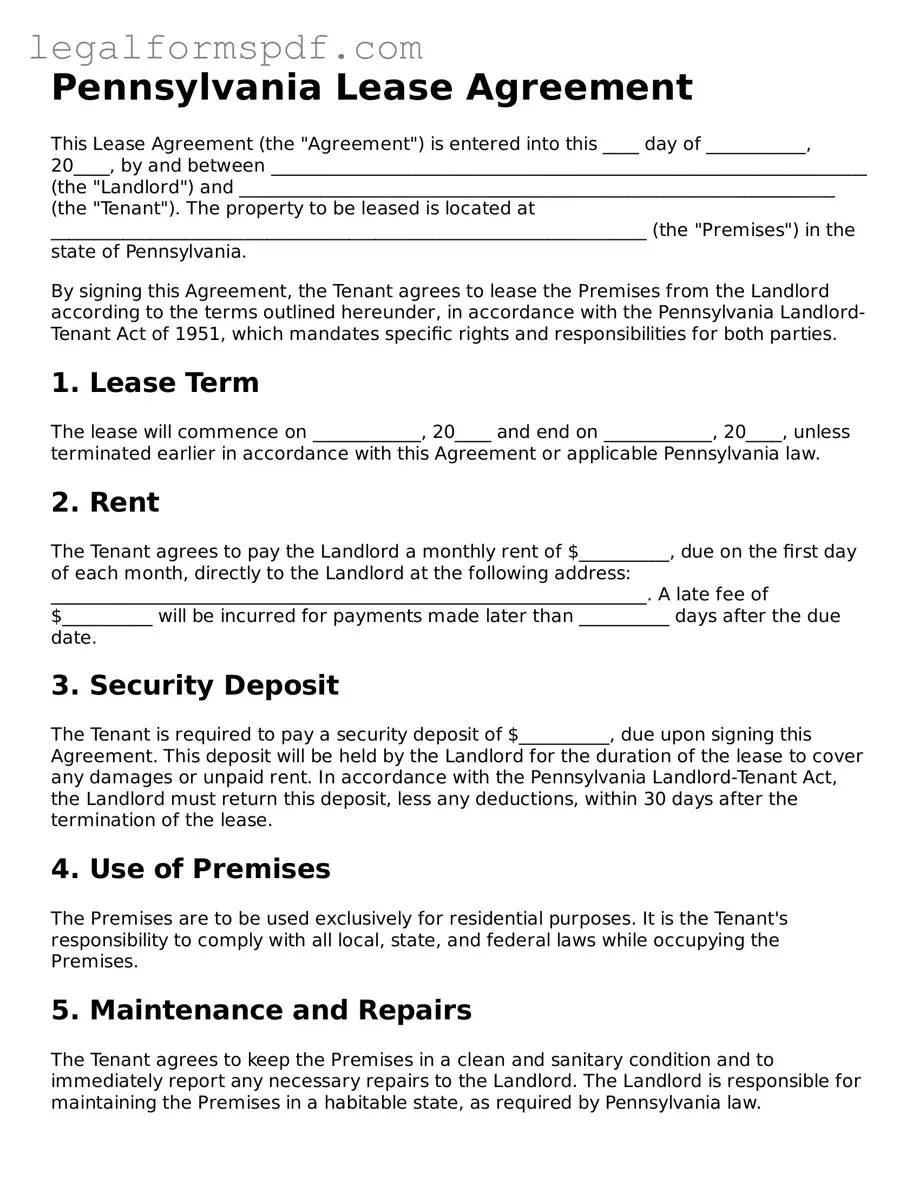What is a Pennsylvania Lease Agreement?
A Pennsylvania Lease Agreement is a legally binding contract between a landlord and a tenant that outlines the terms and conditions of renting property in Pennsylvania. This document specifies details such as the duration of the lease, monthly rent, security deposit, and the rights and responsibilities of both the landlord and tenant.
How do I know if my Pennsylvania Lease Agreement is legally compliant?
For a Pennsylvania Lease Agreement to be legally compliant, it must adhere to all state-specific laws and regulations regarding residential rentals. This includes obeying the Pennsylvania Landlord and Tenant Act, which covers aspects like security deposit limits, notice periods for lease termination, and tenant rights to privacy and habitable living conditions. Consulting with a legal expert or utilizing approved forms can help ensure compliance.
What should be included in a Pennsylvania Lease Agreement?
A typical Pennsylvania Lease Agreement should include the names and contact information of the landlord and tenant, property details, lease term, rent amount and due dates, security deposit details, and any other fees or terms. It should also lay out the rights and duties of each party, rules about pets, noise, and maintenance, along with procedures for terminating the lease.
Can I alter the lease agreement after both parties have signed it?
Yes, but any alterations to the Pennsylvania Lease Agreement after it has been signed by both parties must be made in writing and require the consent of both the tenant and the landlord. This ensures that any changes are mutually agreed upon and legally binding.
What happens if a tenant breaks a Pennsylvania Lease Agreement?
If a tenant breaks a Pennsylvania Lease Agreement, the landlord has the right to seek legal remedies which may include termination of the lease, eviction, and/or financial compensation. The specifics depend on the nature of the lease violation and state law. Tenants have the right to due process and may have defenses available depending on the circumstances surrounding the lease breach.
Are there any restrictions on the amount of security deposit a landlord can charge in Pennsylvania?
Yes, in Pennsylvania, landlords can charge up to two months' rent for the first year of renting. After the first year, the deposit must be reduced to no more than one month's rent. Additionally, the landlord is required to deposit these funds in a federally or state-regulated institution and, after two years, is also obligated to pay interest on the deposit to the tenant.
Is a landlord allowed to enter the rented property without permission in Pennsylvania?
A landlord is required to provide proper notice before entering the rented property in Pennsylvania, except in emergencies. The specific requirements for notice can be outlined in the lease agreement but must be reasonable and comply with state law, typically 24 hours.
What is the process for terminating a Pennsylvania Lease Agreement?
The process for terminating a Pennsylvania Lease Agreement depends on its terms and the reason for termination. Generally, either party must provide written notice to the other. The required notice period often varies based on the reason for termination and the type of lease (e.g., fixed-term or month-to-month). Understanding state laws and the specific lease terms is crucial for properly ending a lease.
Can a Pennsylvania Lease Agreement be terminated early?
Yes, a Pennsylvania Lease Agreement can be terminated early under certain conditions, such as mutual agreement by both the landlord and tenant, a breach of lease terms, or other circumstances outlined in the lease or provided for by law. Each party's rights and obligations regarding early termination should be clearly stated in the lease agreement.
How do security deposits have to be handled at the end of a Pennsylvania Lease Agreement?
At the end of a Pennsylvania Lease Agreement, the landlord must return the security deposit within 30 days, minus any deductions for damages beyond normal wear and tear. The landlord must provide an itemized list of deductions. If the landlord fails to comply with these rules, the tenant may have the right to recover the deposit plus any applicable penalties under state law.
